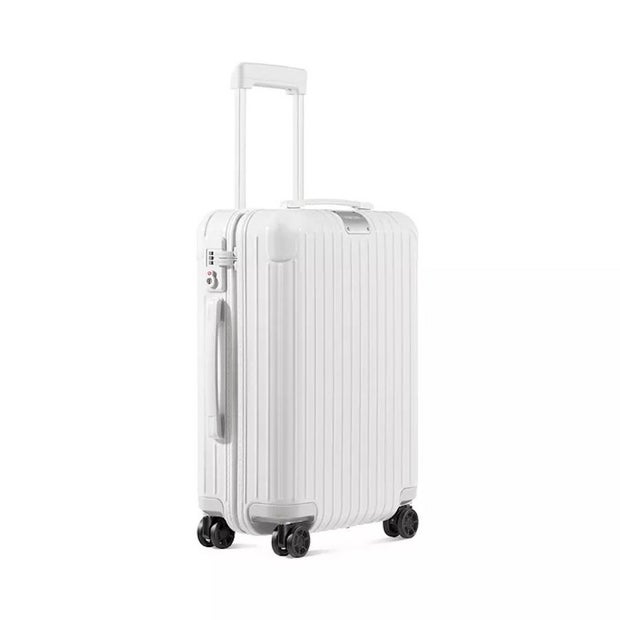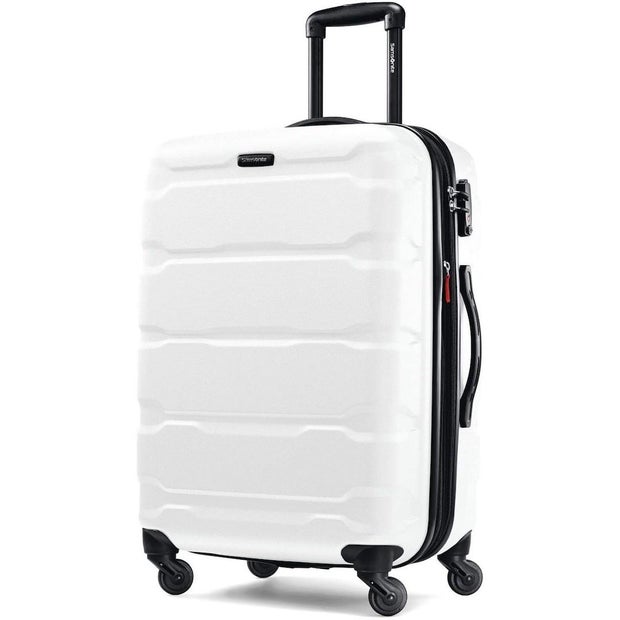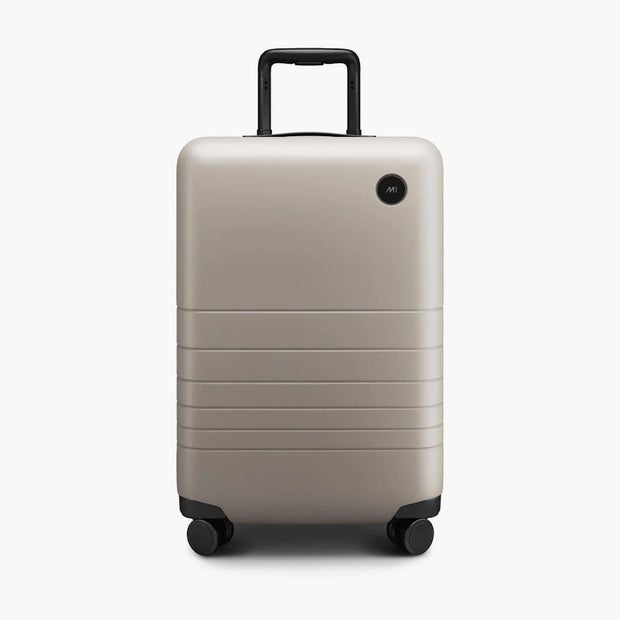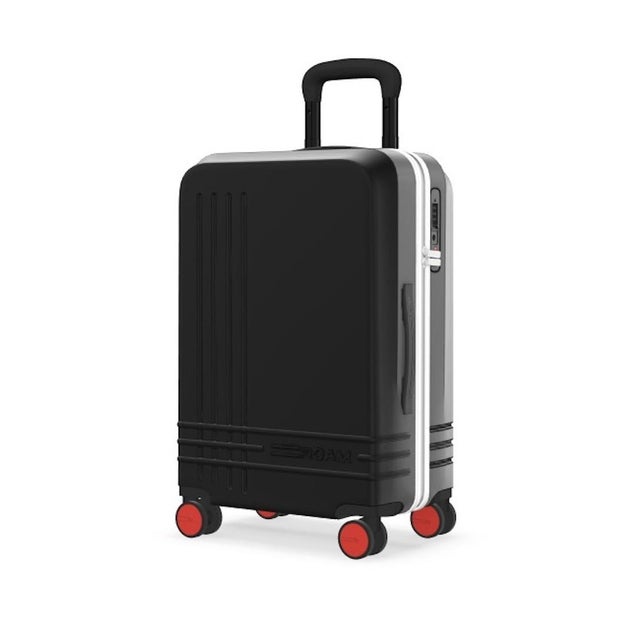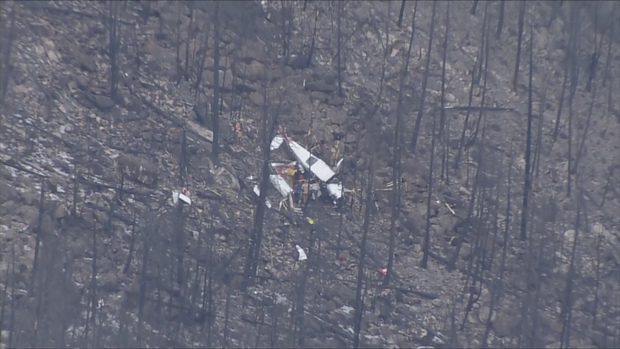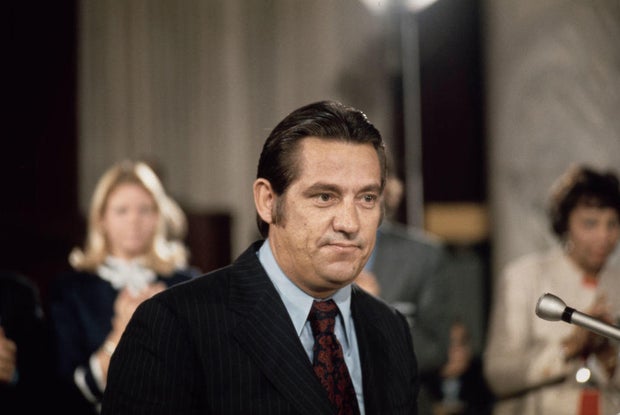CBS News
The best polycarbonate luggage in 2024

Monos / Calpak
Rimowa introduced the first polycarbonate suitcase to the market in 2000. Ever since, hard-sided plastic suitcases — like these top picks — have grown in popularity with travelers. Many of the best luggage pieces of 2024 are polycarbonate suitcases.
Polycarbonate luggage is highly durable, making them an ideal choice for most. Polycarbonate holds its shape during travel, providing stronger protection than softside luggage. And while aluminum luggage makes a great option for luxury travelers, polycarbonate luggage is much more affordable.
Read on for our top polycarbonate luggage picks in 2024, plus more info on what makes polycarbonate luggage different from the other luggage options available.
The best polycarbonate luggage in 2024
We’ve found the best polycarbonate luggage options for all of your 2024 travels from top brands like Rimowa, Away, Monos and more. All these picks are reviewer-loved, with four-star ratings or higher.
Best luxury polycarbonate luggage: Rimowa Essential
Rimowa
The first polycarbonate to hit the market, the Rimowa Essential remains one of the most luxurious polycarbonate luggage pieces you can buy. Available in different sizes and a bunch of glossy and matte color options, the sleek suitcase comes equipped with a TSA-approved lock, a telescopic handle and a smooth, multiwheel system.
Prices start at $850 for the Cabin S size, up to $1,450 for the Trunk Plus.
Why we like the Rimowa Essential:
Looking for something even lighter and lower in price? Check out the lightest Rimowa polycarbonate suitcase, the Essential Lite, weighing 4.6 pounds. Its price starts at $720 at Rimowa.
Best polycarbonate checked bag: Royce & Rocket The Castle
Royce & Rocket
Anyone who struggles to stay organized while living out of a suitcase will appreciate the clever built-in shelving of this checked luggage piece from Royce & Rocket. Neatly stack clothing on the two shelves that emerge when the suitcase opens. There’s a hidden zipper pocket for stashing jewelry and other valuables.
It’s available in burgundy, silver and black exterior colors with the option of a pink or tobacco interior.
Why we like the Royce & Rocket The Castle checked luggage:
Best budget polycarbonate luggage: Samsonite Omni
Samsonite
The polycarbonate Omni, a highly rated and popular piece from Samsonite, offers high quality at a reasonable price. Features include TSA-approved, side-mounted locks, multidirectional spinner wheels, an interior mesh divider and cross straps.
The Omni comes in two checked-bag sizes: a 24-inch suitcase and a larger, 28-inch version (which may fall into the oversized luggage category). Prices vary based on size and color.
Why we like the Samsonite Omni:
- This is one of the best-selling and well-reviewed suitcases on Amazon, where it’s rated 4.5 stars.
- It’s a premium-looking luggage option available for a reasonable price point.
- Comes in a wide range of color options to fit your tastes.
Best polycarbonate luggage with a built-in charger: Away luggage
Away
Away Travel’s spinner wheel bags have amassed a fast following. Their durable, locking polycarbonate bags are stylish and a staff favorite.
“I got the Away The Medium suitcase as a gift this Christmas and it’s completely changed the way I travel,” says CBS Essentials Managing Editor Fox Van Allen. “It’s filled with so many pockets that make organization a breeze — I can find everything in it so quickly. I especially like how easy it is to roll through the airport, even when it’s packed full of heavy things.”
If you don’t like it, return it within 100 days for a full refund.
Why we love Away luggage:
- The compression panel helps you get more clothes into this suitcase when packing.
- Away luggage comes with a lifetime warranty.
- Personalization options are available (at an extra charge).
Best staff-tested polycarbonate luggage: Monos luggage
Monos
Available in a bunch of designer colors, Monos’ polycarbonate luggage features an effortless telescopic handle, lots of pockets and compartments with zippers and an easy-to-use lock. You can read our full review of the Monos carry-on for more details.
Choose from six carry-on options (including two aluminum and polycarbonate hybrids) and two check-in sizes.
Why we Monos luggage:
- Monos carry-ons and checked bags offer smooth, seamless maneuverability according to our testing.
- Monos offers a 100-day trial period and a limited lifetime warranty.
- Monos luggage comes in a variety of stylish colors.
Best sustainable polycarbonate luggage: Paravel Aviator
Paravel
Looking for a sustainable polycarbonate suitcase? The Paravel Aviator is made of all recycled materials, from its interior lining to its aluminum handle to its vegan leather accents. Geared with frictionless, carbon steel-bearing wheels, the Aviator offers 360-degree movement and a telescopic handle, which makes walking (or running) through the airport a breeze.
Paravel offers three sizes: Two carry-on options and a larger check-in.
Why we like the Paravel Aviator:
- The luggage is carbon neutral and made with recycled materials.
- Reviewers state that it is easy to maneuver.
- It features a scuff-hiding textured finish.
Best customizable polycarbonate luggage: Roam luggage
Roam
Design your own polycarbonate suitcase with Roam. The company allows you to customize the color of just about every aspect of your suitcase, from the front and back panels down to the trim. Some of the bags are expandable, giving you extra room to bring home souvenirs.
Not feeling creative? You can also choose from pre-designed bags in appealing colorways. You’ll get great luggage either way.
Why we like Roam luggage:
- You can heavily customize the suitcase and choose your favorite colors.
- Roam suitcases come with a lifetime warranty.
- Roam luggage comes with a 100-day trial period and a lifetime guarantee.
Best colorful polycarbonate luggage: Calpak Hue
Calpak
Available in carry-on and checked sizes, the Calpak Hue collection features a durable polycarbonate exterior, smooth spinner wheels and TSA-approved locks. The Hue collection comes in classic colors as well as more vibrant options.
Why we like Calpak Hue luggage:
- The collection includes a wide range of styles and color options.
- Calpak Hue suitcases feature a zippered interior divider with multiple pockets for easy organization.
- It comes with a two-year warranty.
Why choose polycarbonate luggage?
Compared with leather and textiles, polycarbonate, a form of plastic, has major advantages. Polycarbonate luggage offers ample impact resistance, durability, scratch resistance and water resistance. Plus, it’s lightweight. This makes poly a top option for both checked luggage and carry-on. Polycarbonite luggage travels well on roadtrips, too — the suitcases are easy to get out of a car trunk.
Aluminum luggage offers benefits similar to polycarbonite. But polycarbonite has the advantage of being less expensive than aluminum.
Keep in mind that not all hard-sided, plastic luggage is polycarbonate. ABS, a blend of three plastics, looks strikingly similar to poly, but doesn’t cost so much. The biggest con? The less expensive alternative doesn’t fare as well in terms of durability.
CBS News
2 killed in U.S. Civil Air Patrol plane crash near Palisade Mountain in Northern Colorado

Two people were killed and a third was injured when a U.S. Civil Air Patrol plane crashed in Colorado’s Front Range Saturday morning.
The small passenger plane with three people aboard crashed near Storm Mountain and Palisade Mountain west of Loveland around 11:15 a.m., according to the Larimer County Sheriff’s Office. The plane belonged to the Civil Air Patrol, the civilian auxiliary wing of the U.S. Air Force, and was on a routine aerial photography training mission when it went down, officials said.
Pilot Susan Wolber and aerial photographer Jay Rhoten were identified by CAP as those killed and co-pilot Randall Settergren was identified as the person injured. Settergren was airlifted to an area hospital by a National Guard helicopter, where he is undergoing medical care.
CBS
“The volunteers of Civil Air Patrol are a valuable part of the Department of Military and Veterans Affairs, and the lifesaving work they do on a daily basis directly contributes to the public safety of Coloradans throughout the state,” Maj. Gen. Laura Clellan, adjutant general of the Colorado Department of Military and Veterans Affairs, said in a statement Saturday.
“We are devastated to hear of the loss of Susan Wolber and Jay Rhoten, and the injury of Randall Settergren, during a training mission in Larimer County. Our thoughts and deepest condolences are with the families of those involved in the crash,” Clellan continued. “I would also like to thank all of the first responders who assisted with rescue efforts.”
Palisade Mountain is in Larimer County, about 20 miles west of Loveland and about 65 miles northwest of Denver. The area is part of the burn scar of the Alexander Mountain Fire, which burned almost 10,000 acres in over two weeks this past summer.
The crash happened about 200 feet below the summit of Palisade Mountain in an area that includes tall trees and steep hills as part of the mountain range. Rescue crews were heard on radio traffic working to find a landing zone for rescue helicopters. No structures were impacted by the crash.
The plane crashed in “very rugged” and “extensive and rocky terrain,” Ali Adams, a Larimer County Sheriff’s Office spokeswoman, said at a news conference. First responders had to hike out to the site and the sole survivor was “severely injured” when responders finally got to them.
Rescue efforts were ongoing at 3:15 p.m., according to Adams, and recovery efforts for the two deceased people’s bodies could take several days.
Several agencies responded, including the Loveland Fire Rescue Authority, Thompson Valley EMS and the National Guard.
The Larimer County Sheriff’s Office is the lead agency investigating the crash and the Federal Aviation Administration and National Transportation Safety Board will assist, according to Adams. The NTSB said it too was investigating the crash and identified the plane as a Cessna 182.
“This is one of those incidents that is really low frequency; it doesn’t happen really often, but unfortunately, our first responders have had more than their fair share of responses,” Adams said.
George Solheim lives in the area of the crash. He described conditions as “extremely windy” on Saturday and heard the plane just prior to the crash. He says he could hear “loud ‘throttle up/down’ immediately prior to sudden silence at (the) time of (the) crash. Couldn’t hear sounds of impact from here.”
Colorado Gov. Jared Polis extended his sympathy to the families of the victims in a statement Saturday evening:
“I’m saddened to hear of the loss of two dedicated Civil Air Patrol members, Pilot Susan Wolber and aerial photographer Jay Rhoten, who lost their lives in today’s crash and my thoughts are with their families, friends and colleagues. These individuals, along with survivor co-pilot Randall Settergren, who was injured, served the Civil Air Patrol as volunteers who wanted to help make Colorado a better, safer place for all. The State of Colorado is grateful for their commitment to service and it will not be forgotten. I also want to thank the first responders who assisted with the rescue and recovery efforts.”
CBS News
Fred Harris, former Democratic U.S. senator and presidential candidate, dies at 94

Fred Harris, a former U.S. senator from Oklahoma, presidential hopeful and populist who championed Democratic Party reforms in the turbulent 1960s, died Saturday. He was 94.
Harris’ wife, Margaret Elliston, confirmed his death to The Associated Press. He had lived in New Mexico since 1976.
“Fred Harris passed peacefully early this morning of natural causes. He was 94. He was a wonderful and beloved man. His memory is a blessing,” Elliston said in a text message.
Bettmann Archive/Getty Images
Harris served eight years in the Senate, first winning in 1964 to fill a vacancy, and made unsuccessful bid for the presidency in 1976.
“I am deeply saddened to learn of the passing of my longtime friend Fred Harris today,” Democratic New Mexico Gov. Michelle Lujan Grisham wrote in a post to social media. “Harris was a towering presence in politics and in academia, and his work over many decades improved New Mexico and the nation. He will be greatly missed.”
Democratic Sen. Martin Heinrich of New Mexico said in a statement that “New Mexico and our nation have lost a giant,” describing him as a “tireless champion of civil rights, tribal sovereignty and working families.”
It fell to Harris, as chairman of the Democratic National Committee in 1969 and 1970, to help heal the party’s wounds from the tumultuous national convention in 1968 when protesters and police clashed in Chicago.
He ushered in rule changes that led to more women and minorities as convention delegates and in leadership positions.
“I think it’s worked wonderfully,” Harris recalled in 2004, when he was a delegate to the Democratic National Convention in Boston. “It’s made the selection much more legitimate and democratic.”
“The Democratic Party was not democratic, and many of the delegations were pretty much boss-controlled or -dominated. And in the South, there was terrible discrimination against African Americans,” he said.
Harris ran unsuccessfully for the Democratic presidential nomination in 1976, quitting after poor showings in early contests, including a fourth-place win in New Hampshire. The more moderate Jimmy Carter went on to win the presidency.
Harris moved to New Mexico that year and became a political science professor at the University of New Mexico. He wrote and edited more than a dozen books, mostly on politics and Congress. In 1999 he broadened his writings with a mystery set in Depression-era Oklahoma.
Throughout his political career, Harris was a leading liberal voice for civil rights and anti-poverty programs to help minorities and the disadvantaged. Along with his first wife, LaDonna, a Comanche, he also was active in Native American issues.
“I’ve always called myself a populist or progressive,” Harris said in a 1998 interview. “I’m against concentrated power. I don’t like the power of money in politics. I think we ought to have programs for the middle class and working class.”
“Today ‘populism’ is often a dirty word because of how certain leaders wield power,” Heinrich said in his statement Saturday. “But Fred represented a different brand of populism — one that was never mean or exclusionary. Instead, Fred focused his work and attention on regular people who are often overlooked by the political class.”
Harris was a member of the National Advisory Commission on Civil Disorders, the so-called Kerner Commission, appointed by then-President Lyndon Johnson to investigate the urban riots of the late 1960s.
The commission’s groundbreaking report in 1968 declared, “our nation is moving toward two societies, one black, one white — separate and unequal.”
Thirty years later, Harris co-wrote a report that concluded the commission’s “prophecy has come to pass.”
“The rich are getting richer, the poor are getting poorer and minorities are suffering disproportionately,” said the report by Harris and Lynn A. Curtis, president of the Milton S. Eisenhower Foundation, which continued the work of the commission.
Norman Ornstein of the American Enterprise Institute said Harris rose to prominence in Congress as a “fiery populist.”
“That resonates with people…the notion of the average person against the elite,” Ornstein said. “Fred Harris had a real ability to articulate those concerns, particularly of the downtrodden.”
In 1968, Harris served as co-chairman of the presidential campaign of then-Vice President Hubert Humphrey. He and others pressed Humphrey to use the convention to break with Johnson on the Vietnam War. But Humphrey waited to do so until late in the campaign, and narrowly lost to Republican Richard Nixon.
“That was the worst year of my life, ’68. We had Dr. Martin Luther King killed. We had my Senate seatmate Robert Kennedy killed and then we had this terrible convention,” Harris said in 1996.
“I left the convention — because of the terrible disorders and the way they had been handled and the failure to adopt a new peace platform — really downhearted.”
After assuming the Democratic Party leadership post, Harris appointed commissions that recommended reforms in the procedures for selecting delegates and presidential nominees. While lauding the greater openness and diversity, he said there had been a side effect: “It’s much to the good. But the one result of it is that conventions today are ratifying conventions. So it’s hard to make them interesting.”
“My own thought is they ought to be shortened to a couple of days. But they are still worth having, I think, as a way to adopt a platform, as a kind of pep rally, as a way to get people together in a kind of coalition-building,” he said.
Harris was born Nov. 13, 1930, in a two-room farmhouse near Walters, in southwestern Oklahoma, about 15 miles from the Texas line. The home had no electricity, indoor toilet or running water.
At age 5 he was working on the farm and received 10 cents a day to drive a horse in circles to supply power for a hay bailer.
He worked part-time as a janitor and printer’s assistant to help for his education at University of Oklahoma. He earned a bachelor’s degree in 1952, majoring in political science and history. He received a law degree from the University of Oklahoma in 1954, and then moved to Lawton to practice.
In 1956, he won election to the Oklahoma state Senate and served for eight years. In 1964, he launched his career in national politics in the race to replace Sen. Robert S. Kerr, who died in January 1963.
Harris won the Democratic nomination in a runoff election against J. Howard Edmondson, who left the governorship to fill Kerr’s vacancy until the next election. In the general election, Harris defeated an Oklahoma sports legend — Charles “Bud” Wilkinson, who had coached OU football for 17 years.
Harris won a six-year term in 1966 but left the Senate in 1972 when there were doubts that he, as a left-leaning Democrat, could win reelection.
Harris married his high school sweetheart, LaDonna Vita Crawford, in 1949, and had three children, Kathryn, Byron and Laura. After the couple divorced, Harris married Margaret Elliston in 1983. A complete list of survivors was not immediately available Saturday.
CBS News
Compromise deal reached at COP29 climate talks for $300 billion a year to poor nations

Countries agreed on a deal to inject at least $300 billion annually in humanity’s fight against climate change, aimed at helping poor nations cope with the ravages of global warming at tense United Nations climate talks in the city where industry first tapped oil.
The $300 billion will go to developing countries who need the cash to wean themselves off the coal, oil and gas that causes the globe to overheat, adapt to future warming and pay for the damage caused by climate change’s extreme weather. It’s not near the full amount of $1.3 trillion that developing countries were asking for, but it’s three times the $100 billion a year deal from 2009 that is expiring. Delegations said this deal is headed in the right direction, with hopes that more money flows in the future.
“Everybody is committed to having an agreement,” Fiji delegation chief Biman Prasad said as the deal was being finalized. “They are not necessarily happy about everything, but the bottom line is everybody wants a good agreement.”
It’s also a critical step toward helping countries on the receiving end create more ambitious targets to limit or cut emissions of heat-trapping gases that are due early next year. It’s part of the plan to keep cutting pollution with new targets every five years, which the world agreed to at the U.N. talks in Paris in 2015.
The Paris agreement set the system of regular ratcheting up climate fighting ambition as away to keep warming under 1.5 degrees Celsius above pre-industrial levels. The world is already at 1.3 degrees Celsius and carbon emissions keep rising.
Countries also anticipate that this deal will send signals that help drive funding from other sources, like multilateral development banks and private sources. That was always part of the discussion at these talks — rich countries didn’t think it was realistic to only rely on public funding sources — but poor countries worried that if the money came in loans instead of grants, it would send them sliding further backward into debt that they already struggle with.
“The $300 billion goal is not enough, but is an important down payment toward a safer, more equitable future,” said World Resources Institute President Ani Dasgupta. “This deal gets us off the starting block. Now the race is on to raise much more climate finance from a range of public and private sources, putting the whole financial system to work behind developing countries’ transitions.”
It’s more than the $250 billion that was on the table in the first draft of the text, which outraged many countries and led to a period of frustration and stalling over the final hours of the summit. After an initial proposal of $250 billion a year was soundly rejected, the Azerbaijan presidency brewed up a new rough draft of $300 billion, that was never formally presented, but also dismissed roundly by African nations and small island states, according to messages relayed from inside.
The several different texts adopted early Sunday morning included a vague but not specific reference to last year’s Global Stocktake approved in Dubai. Last year there was a battle about first-of-its-kind language on getting rid of the oil, coal and natural gas, but instead it called for a transition away from fossil fuels. The latest talks only referred to the Dubai deal, but did not explicitly repeat the call for a transition away from fossil fuels.
Countries also agreed on the adoption of Article 6, creating markets to trade carbon pollution rights, an idea that was set up as part of the 2015 Paris Agreement to help nations work together to reduce climate-causing pollution. Part of that was a system of carbon credits, allowing nations to put planet-warming gasses in the air if they offset emissions elsewhere. Supporters said a U.N.-backed market could generate up to an additional $250 billion a year in climate financial aid.
Despite its approval, carbon markets remain a contentious plan because many experts say the new rules adopted don’t prevent misuse, don’t work and give big polluters an excuse to continue spewing emissions.
“What they’ve done essentially is undermine the mandate to try to reach 1.5,” said Tamara Gilbertson, climate justice program coordinator with the Indigenous Environmental Network. Greenpeace’s An Lambrechts, called it a “climate scam” with many loopholes.
With this deal wrapped up as crews dismantle the temporary venue, many have eyes on next year’s climate talks in Belem, Brazil.



